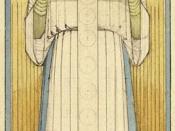Living in the hustle and bustle of our own worlds, hardly do we step back and observe the surroundings and indulge in our innate curiosity of creation. Some of us might already hold a fervent belief of how the world came into existence, and this belief system is most likely related to one's religious or cultural background. Certain groups have their own interpretation of how creation came about and these stories are passed onto members or followers. For the rest of us who lack a strong affiliation to any belief system, we might not have our own developed explanation of creation. Because the creation of the universe has fascinated mankind for ages, creation stories are formulated in attempt to provide answers to the question of existence. People want to explain phenomenon and the unknown and creation myths serve to give reasoning to these mysteries, no matter how bizarre and unrealistic they may be to us now.
There are countless creation stories that have been circulated and documented. Even though these religious or spiritual writings may differ in their themes and morals, there exist common elements that link many of these myths to one another. Many of these stories of creation begin with the world being vast emptiness or darkness. In the Judeo-Christian version on creation, it describes the universe as " waste and void; darkness covered the abyss..." (Genesis). Similarly, the Hindu tradition begins with the world being dark and hollow. "Then even nothingness was not, nor existence. There was no air then, nor the heavens beyond it... At first there was only darkness wrapped in darkness..." (Rig-Veda).
Another element widely seen in many of these myths is the presence of an omniscient creator or power that gives life to the emptiness. This Supreme Being is usually the center of...


